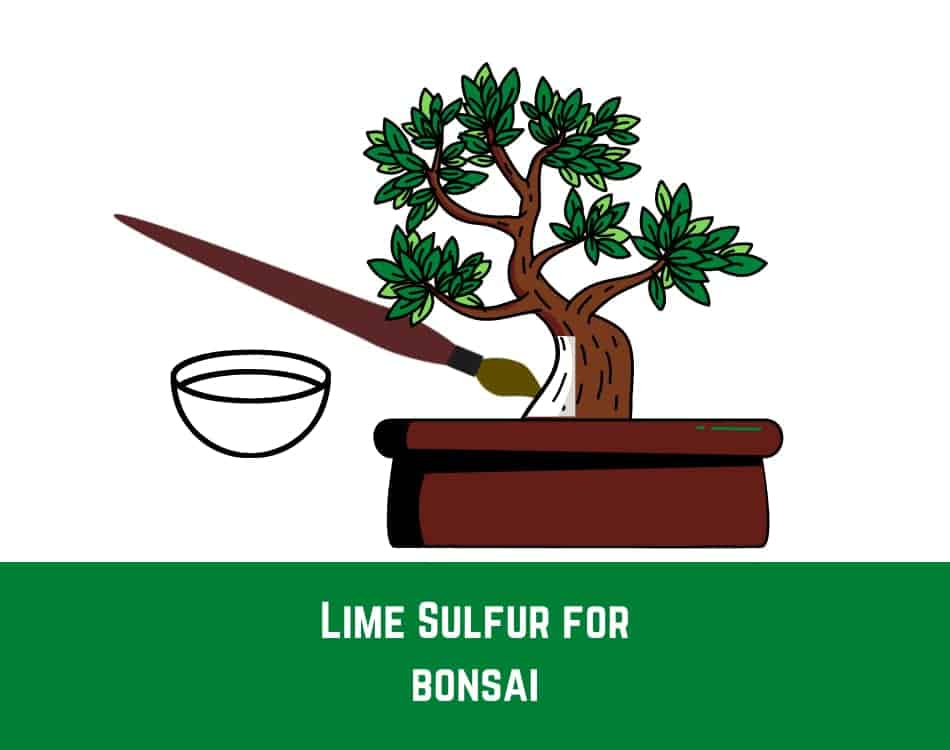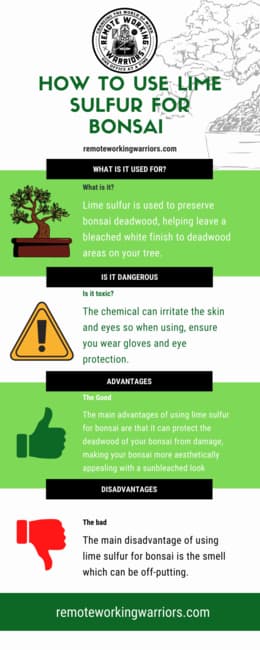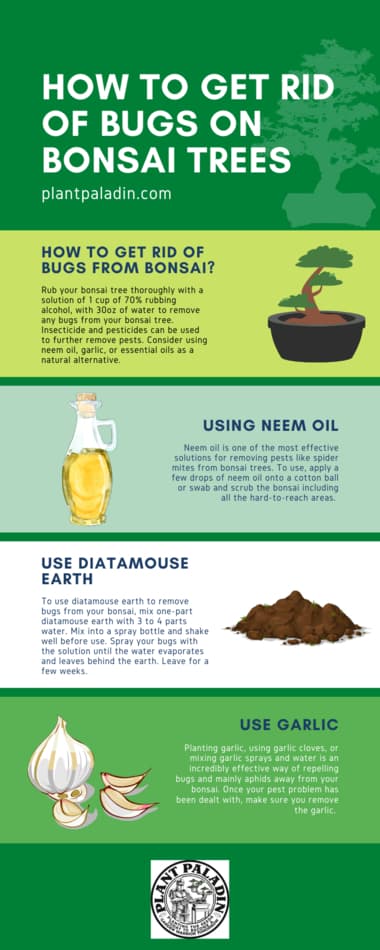This website is supported by its readers. If you click one of my links I may earn a commission. I am also a participant in the Amazon affiliates program and I will also earn a commission from qualified purchases.

So one of the things I’ve started exploring with my small bonsai nursery is deadwood techniques. Jin, Sabamiki, and other methods have transformed my trees from looking amateur to looking like how I first imagined them. One of the things I was worried about however was preserving the weakened deadwood. Luckily, I stumbled across lime sulfur for bonsai.
Lime sulfur is used to preserve bonsai deadwood, helping leave a bleached white finish to deadwood areas on your tree. Its other uses in bonsai are as a fungicide, insecticide, or a repellent for birds. Lime sulfur should be handled with care due to its smell and reaction to skin and eyes.
So how exactly do you use lime sulfur for bonsai? And where exactly can you get lime sulfur for bonsai from? Keep reading to find out more!
Just a quick heads up, over the past three years of running Plantpaladin, hundreds of people have asked for product recommendations. As such, You can find my favorite indoor bonsai tree here (link takes you to Bonsaiboy), my favorite outdoor bonsai tree (link takes you to Bonsaiboy), or have a look at all the products I recommend here.
Lime sulfur bonsai
Despite its smell, or perceived complexity to use, lime sulfur is a fantastic solution that can be used for a variety of bonsai-related applications.
These include:
- Preserving and coloring deadwood
- Insecticide
- Fungicide
- As a bird repellent
To help explain more I’ve put together a table which briefly shows how to use them for the above:
| Lime sulfur use |
How to use |
| Preserving deadwood | Clean your bonsai with a mix of vinegar and water. Then when your bonsai is moist, rub the lime sulfur onto the deadwood areas of your tree and leave it to dry. |
| As an insecticide | Mix one part lime sulfur to 30 parts water and put into a spray bottle. Spray your plant thoroughly. Rinse off afterward. |
| As a fungicide | Mix one part lime sulfur to 30 parts water and put into a spray bottle. Spray your plant thoroughly. Rinse off afterward. |
| As a bird repellent | Spraying with the above mix will stop birds from picking your fruit or foraging near them during the winter months. |
Now each of these will be applied in different ways and have its own set of rules so let’s explore these in more detail below.

Lime sulfur for bonsai deadwood
So easily the most common reason why we bonsai enthusiasts use lime sulfur is to preserve and protect our bonsai deadwood.
Bonsai deadwood techniques are incredibly common, often used by professional bonsai owners as a way to make their bonsai stand out.
A few deadwood techniques include:
Jin – whereby you remove the cambium from a branch turning it into a deadwood branch
Sabamiki – where you create an artificial crack in the trunk of your bonsai giving the illusion of a natural break or lighting strike in your tree.
Whilst doing these techniques is aesthetically appealing, they can weaken and damage the tree – often cutting off the nutrient and sap flow throughout your tree.
Using lime sulfur then will help preserve the deadwood area of your bonsai – protecting the deadwood from the elements and helping reverse some of the damage.
Think of it as a varnish for a garden fence as a way of helping it through the year.
How to use lime sulfur for bonsai deadwood?
So applying lime sulfur to your bonsais deadwood can be a little bit complex if you are new to bonsai.
To help, I’ve broken this down in step-by-step methods below
Move your bonsai to your workstation
Before we start using lime sulfur we must take a few precautions.
Lime sulfur has a very potent smell and will ruin pretty much everything it comes into contact with.
It’s important then that you remove it from the rest of your bonsai tree.
I personally like to use an old coffee table to work from.
I move this outdoors, cover it with a tablecloth or old newspaper.
I’d also recommend using the following:
- Eye protection such as goggles
- A mask
- Thick garden gloves
All of which should be worn when handling the lime sulfur.
Ensure you have deadwood on your bonsai
For those of you who already have deadwood on your bonsai, you can skip this step.
For the rest of you, applying lime sulfur to a bonsai without deadwood to preserve it just isn’t going to work.
You see lime sulfur stains a lot and so you can end up damaging the soil or bark of your plant if there is no deadwood on it.
If you are interested in learning more about how to create bonsai deadwood techniques, read up on the deadwood content I shared earlier in the post.
Cover the soil
As lime sulfur can stain everything it can very easily damage and poison the soil of your plant.
Leaving it ripe for infection like mold to take place.
To avoid this altogether, cover the topsoil of your bonsai with either newspaper or material your can dispose of easily.
if you do get lime sulfur on your soil, use a mix that allows moisture to flow freely such as a cactus mix to ensure it does not do too much damage.
Clean the deadwood with water and vinegar
So before we apply the lime sulfur we must clean the deadwood on your bonsai.
Without cleaning the bonsai deadwood, dirt grime and even fungus and algae will start to grow on the deadwood.
The best thing you can do is mix a solution of one part vinegar with ten parts water and brush the deadwood areas of the tree until they are clean.
The vinegar will also help in removing any bugs or eggs that might be laying around the tree.
I like to use an old toothbrush, simply dip in your vinegar/water solution and brush the deadwood areas until clean.
Ensure your tree is moist
The final bit of prep work you will need to do is ensure that the tree and the deadwood area in particular are moist.
This is because if the deadwood is moist, it will ensure that the lime sulfur will absorb as deep into the deadwood areas as possible.
Having a moist tree will also mean that it will turn whiter and get the bleached look a lot faster than if the tree was just wet.
Doing this after you have cleaned the deadwood with the vinegar solution will also show that you’re watering any excess vinegar out of your bonsai which can also dry out your tree.
To moisten your tree, use a spray bottle filled with water and then spray your tree down thoroughly.
I like to then use paper towels as a way to pat dry the tree so that it is still moist.
Tape the tree
So this step is optional but I would recommend especially as lime sulfur can run.
If you don’t have a steady hand, consider putting duck tape on the perimeter of the deadwood areas so it does not affect the rest of your plant.
Apply your first coat of lime sulfur
Now for the fun stuff.
Pour the lime sulfur into an easy-to-access bowl.
Then using a paintbrush apply a thin layer of lime sulfur on the deadwood area.
Start from the top of the deadwood and then work your way down.
At this time all we are after is a thin layer.
Now your brush will likely have a lot of excess lime sulfur on it so keep a cloth nearby that you can wipe off your brush on.
Let the bonsai dry for 2 to 3 hours
Next, let the bonsai dry for a few hours, this should hopefully give enough time for the thin layer of lime sulfur to work its magic.
Apply a second thin layer
The next step is to redo and reapply another thin layer of lime sulfur.
Applying two thin layers will ensure that the deadwood area will really pop in color and ensure that you won’t be exposed to the pretty awful smell of the lime sulfur for too long.
Then leave to dry once again for another 2-3 hours.
Apply a thick layer
Finally, apply a thick layer that should cover the deadwood area.
Using the same techniques with the brushes.
Again just ensure that you have a rag nearby as you will have a lot more excess lime sulfur that will drip off during the process.
Once the thick layer has been applied, if the weather is good, I would recommend keeping your bonsai outdoors to dry in the sun.
This should take around 8 hours to be completely dry.
You’ll know when you are done when a nice white color will be showing in the deadwood areas.
Lime sulfur as an insecticide
Lime sulfur also has a fantastic opportunity in removing pests – particularly in the winter months when used as a winter wash.
All bonsai owners know just how difficult managing pests can be during any time of the year and the same goes for winter.
Using lime sulfur, in a mix of one part lime sulfur, 30 parts water, and then spraying your tree will work as an insect repellent.
Just ensure you spray your plant with water a few hours after you apply the lime sulfur solution as it will start to smell.

Lime sulfur as a fungicide
One of the biggest reasons why we use lime sulfur for the deadwood area of our bonsai trees is to strengthen these weakened areas.
These weakened areas mean that your bonsai will be more susceptible to fungal disease – most often which display themselves as white spots or powder on the leaves of your plant.
Again, mix a solution of one part lime sulfur with 25 to 30 parts water and spray your tree.
To make it easy I like to use one tablespoon of lime sulfur with 30 oz of water.
This solution tends to work best.
If you find that the lime sulfur doesn’t remove the fungus fully, then check out this post on how to remove fungus from your bonsai here.
Lime sulfur as a bird repellent
Whilst birds won’t directly feed on some bonsai – especially if your bonsai does not bear fruit.
Birds can make a mess, having a dry shower or foraging for food – which can disturb the nearby environment, especially if our trees are planted outside or in the ground.
To use, spray a tiny amount of lime sulfur ( literally one teaspoon) with a mix of 30 oz of water and spray your tree.
This should be enough dilution so that your bonsai does not get impacted by the lime sulfur but enough that the bird’s sense of smell will put them off from going near your bonsai.
What is lime sulfur for bonsai?
Lime sulfur is a chemical that is used to preserve the deadwood areas in bonsai trees. This process also brings out the color in bonsai deadwood leaving a nice white finish. It is typically made up of is a chemical compound made up of calcium polysulfides and thiosulfate and can also be used as an insect repellant.
Where can you get lime sulfur for bonsai?
As lime sulfur is used not only for bonsai but for animals and pet care, trying to find lime-sulfur specifically for bonsai can be a challenge.
Luckily I found that Beechfield has relatively inexpensive lime sulfur that should be good for two to three bonsais and should cover plenty of deadwood space.
Alternatively, most garden centers should stock it.
I would avoid getting lime sulfur not designed for bonsai so opting for a dog or pet lime sulfur should definitely be avoided.
What are the benefits of using lime sulfur for bonsai?
The main advantages of using lime sulfur for bonsai are that it can protect the deadwood of your bonsai from damage, making your bonsai more aesthetically appealing with a sunbleached look. It also works well as a fungicide and insecticide.
What are the disadvantages of using lime sulfur for bonsai?
The main disadvantage of using lime sulfur for bonsai is the smell which can be off-putting. Lime sulfur is also a harsh chemical to use meaning if it touches the skin or eyes, it can cause significant damage. Leaving the lime sulfur on your bonsai for too long may also damage your bonsai.
What does lime sulfur for bonsai work best for?
Lime sulfur works best for bonsai when used as a preserving agent for deadwood elements such as jin or sabamiki. Lime sulfur also works best as an insecticide, fungicide and can be used as a deterrent for birds.
What does lime sulfur smell like?
Lime sulfur has the strong smell of rotten eggs and so using it on your bonsai will also mean your bonsai will temporarily smell like rotten eggs. It’s important to wash off the lime sulfur after a few hours with water to reduce the impact of this smell.
How often should you use lime sulfur on your bonsai?
Lime sulfur should be used once per year on the deadwood of your bonsai as a way to protect your tree. Using it more than once per year will not prove to be advantageous and will increase the chance of the lime sulfur spilling on the rest of your bonsai.
Is lime sulfur dangerous for bonsai?
Lime sulfur is incredibly dangerous and should be handled with care if using for bonsai. The chemical can irritate the skin and eyes so when using, ensure you wear gloves and eye protection.
Can you use lime sulfur on all bonsai species?
Lime sulfur can be used as an insecticide fungicide and bird repellent on all bonsai, although it is preferential to only use it on outdoor bonsai due to the smell. It should only be used on bonsai with deadwood if using it for preservation purposes.
Does lime sulfur preserve deadwood in bonsai?
Whilst lime sulfur offers some degree of protection against bacteria and fungal infections. It is relatively shot-lived. The bleached look lasts a lot longer which can cause some bonsai owners to think the protection is year-round.
A good summary then is whilst lime sulfur can be used to preserve the top layers of deadwood, it should not be seen as the be-all, end-all of preservatives and in the long term will not prevent deadwood on your bonsai from rotting.
My top picks for the gear you will need!
So like I mentioned earlier, over the past three years of running PlantPaladin, hundreds of people have asked me for my recommendations on the best bonsai gear on the market.
Having spent thousands of dollars on bonsai items these past few years and tested at least 100 bonsai-specific products, I’ve listed my favorite products below – All of which I highly recommend and think you can get great value.
They can purchase directly by clicking the link to take them to Amazon.
Bonsai Tool Set: One of the significant challenges I’ve had is finding a toolset that was not only durable but didn’t break the bank. SOLIGT has recently developed a fantastic bonsai tool set that covers all the tools you need to trim, prune, and repot your trees. – You can grab it here.
Complete Bonsai Set: Many of you will want to grow your bonsai trees entirely from scratch, but finding the varicose seeds, pots, and other items in one place can be challenging. Leaves and Sole then have created a complete bonsai set that I’ve personally used that ticks all the boxes. You can grab it here.
Bonsai wire: The number of times I’ve run out of wire for my bonsai or purchased cheap bonsai wire that doesn’t do the job is embarrassing for me to admit. After a lot of trial and error, I found that using Hotop’s aluminum bonsai wire is one of the best options on the market. This can easily be used for both indoor and outdoor bonsai. You can grab it here.
This post was written by Fehed Nicass who has been passionate about bonsai for over 2 years. He currently resides in the UK and works in sales.

